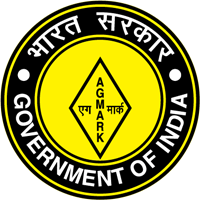Agmark: Difference between revisions
No edit summary |
Yashsaini24 (talk | contribs) No edit summary |
||
| Line 10: | Line 10: | ||
| homepage = {{URL|agmarknet.nic.in/agm_std1.htm}} |
| homepage = {{URL|agmarknet.nic.in/agm_std1.htm}} |
||
}} |
}} |
||
'''AGMARK''' is a [[certification mark]] employed on agricultural products in [[India]], assuring that they conform to a set of standards approved by the ''Directorate of Marketing and Inspection'', an agency of the [[Government of India]].<ref name="agmarknet-agm_std1">[http://agmarknet.nic.in/agm_std1.htm Directorate of Marketing and Inspection. 'Promotion of Standardisation and Grading of Agricultural and Allied Produce'.]</ref><ref>{{cite web|url=http://mofpi.nic.in/ContentPage.aspx?CategoryId=141|title=:: Ministry of Food Processing Industries ::|publisher=|accessdate=29 May 2015}}</ref><ref>{{cite web|url=http://www.thehindu.com/todays-paper/tp-national/tp-tamilnadu/article2670176.ece|title=Slush and stench|work=The Hindu|accessdate=29 May 2015}}</ref><ref>{{cite web|url=http://www.thehindu.com/todays-paper/tp-national/tp-kerala/article2140908.ece?css=print|title=Nectar of kindness|author=K. Santhosh|work=The Hindu|accessdate=29 May 2015}}</ref><ref>{{cite web|url=http://www.thehindu.com/todays-paper/tp-national/tp-kerala/article2398861.ece?textsize=large&test=1|title=Minister inaugurates open auction system at market|author=Staff Reporter|work=The Hindu|accessdate=29 May 2015}}</ref><ref>[http://www.nios.ac.in/Secbuscour/26.pdf National Institute of Open Schooling. 'Wise Buying.']</ref> The ''AGMARK'' is legally enforced in India by the ''Agricultural Produce (Grading and Marking) Act of 1937 (and amended in 1986)''.<ref name="agmarknet-agm_std1" /> The present ''AGMARK'' standards cover quality guidelines for 213 different commodities spanning a variety of [[Pulses]], [[Cereals]], [[Essential Oils]], [[vegetable oil]]s, Fruits & Vegetables, and semi-processed products like [[Vermicelli]].<ref name="agmarknet-agm_std1" /> |
'''AGMARK''' is a [[certification mark]] employed on agricultural products in [[India]], assuring that they conform to a set of standards approved by the ''Directorate of Marketing and Inspection'', an agency of the [[Government of India]].<ref name="agmarknet-agm_std1">[http://agmarknet.nic.in/agm_std1.htm Directorate of Marketing and Inspection. 'Promotion of Standardisation and Grading of Agricultural and Allied Produce'.]</ref><ref>{{cite web|url=http://mofpi.nic.in/ContentPage.aspx?CategoryId=141|title=:: Ministry of Food Processing Industries ::|publisher=|accessdate=29 May 2015}}</ref><ref>{{cite web|url=http://www.thehindu.com/todays-paper/tp-national/tp-tamilnadu/article2670176.ece|title=Slush and stench|work=The Hindu|accessdate=29 May 2015}}</ref><ref>{{cite web|url=http://www.thehindu.com/todays-paper/tp-national/tp-kerala/article2140908.ece?css=print|title=Nectar of kindness|author=K. Santhosh|work=The Hindu|accessdate=29 May 2015}}</ref><ref>{{cite web|url=http://www.thehindu.com/todays-paper/tp-national/tp-kerala/article2398861.ece?textsize=large&test=1|title=Minister inaugurates open auction system at market|author=Staff Reporter|work=The Hindu|accessdate=29 May 2015}}</ref><ref>[http://www.nios.ac.in/Secbuscour/26.pdf National Institute of Open Schooling. 'Wise Buying.']</ref>It is a combination of two words which are AG and MARK. AG means agriculture and MARK which means certification.<ref>{{Cite web|url = https://www.legalraasta.com/agmark-registration-in-india/|title = Agmark|date = |accessdate = |website = AGMARK Registration in India|publisher = Legalraasta|last = Jain|first = Pulkit}}</ref> The ''AGMARK'' is legally enforced in India by the ''Agricultural Produce (Grading and Marking) Act of 1937 (and amended in 1986)''.<ref name="agmarknet-agm_std1" /> The present ''AGMARK'' standards cover quality guidelines for 213 different commodities spanning a variety of [[Pulses]], [[Cereals]], [[Essential Oils]], [[vegetable oil]]s, Fruits & Vegetables, and semi-processed products like [[Vermicelli]].<ref name="agmarknet-agm_std1" /> |
||
== Etymology == |
== Etymology == |
||
Revision as of 13:30, 12 February 2016
| AGMARK | |
|---|---|
 | |
| Certifying agency | Directorate of Marketing and Inspection, Government of India |
| Effective region | India |
| Effective since | 1986 |
| Product category | Agricultural products |
| Legal status | Advisory |
| Website | agmarknet |
AGMARK is a certification mark employed on agricultural products in India, assuring that they conform to a set of standards approved by the Directorate of Marketing and Inspection, an agency of the Government of India.[1][2][3][4][5][6]It is a combination of two words which are AG and MARK. AG means agriculture and MARK which means certification.[7] The AGMARK is legally enforced in India by the Agricultural Produce (Grading and Marking) Act of 1937 (and amended in 1986).[1] The present AGMARK standards cover quality guidelines for 213 different commodities spanning a variety of Pulses, Cereals, Essential Oils, vegetable oils, Fruits & Vegetables, and semi-processed products like Vermicelli.[1]
Etymology
The term agmark was coined by joining the words 'Ag' to mean agriculture and 'mark' for a certification mark. This term was introduced originally in the bill presented in the parliament of India for the Agricultural Produce (Grading and Marking) Act.[8]
The entire system of Agmark, including the name, was created by Archibald Macdonald Livingstone, Agricultural and Marketing Advisor to the Government of India, from 1934 to 1941. He was supported by a staff of several hundred. The system was designed to benefit local growers throughout India who were, in the absence of a certification as to quality, exposed to receiving less for their produce from dealers than its true worth.[9]
Agmark Laboratories
The Agmark certification is employed through fully state-owned Agmark laboratories located across the nation which act as testing and certifying centres. In addition to the Central AGMARK Laboratory (CAL) in Nagpur, there are Regional AGMARK Laboratories (RALs) in 11 nodal cities (Mumbai, New Delhi, Chennai, Kolkata, Kanpur, Kochi, Guntur, Amritsar, Jaipur, Rajkot, Bhopal).[10] Each of the regional laboratories is equipped with and specializes in the testing of products of regional significance. Hence the product range that could be tested varies across the centres.[11]
Commodities and tests
The testing done across these laboratories include chemical analysis, microbiological analysis, pesticide residue, and aflatoxin analysis on whole spices, ground spices, ghee, butter, vegetable oils, mustard oil, honey, foodgrains (wheat), wheat products (atta, suji, and maida), gram flour, soyabean seed, bengal gram, ginger, oil cake, essential oil, oils and fats, animal casings, meat and food products.[11]
See also
References
- ^ a b c Directorate of Marketing and Inspection. 'Promotion of Standardisation and Grading of Agricultural and Allied Produce'.
- ^ ":: Ministry of Food Processing Industries ::". Retrieved 29 May 2015.
- ^ "Slush and stench". The Hindu. Retrieved 29 May 2015.
- ^ K. Santhosh. "Nectar of kindness". The Hindu. Retrieved 29 May 2015.
- ^ Staff Reporter. "Minister inaugurates open auction system at market". The Hindu. Retrieved 29 May 2015.
- ^ National Institute of Open Schooling. 'Wise Buying.'
- ^ Jain, Pulkit. "Agmark". AGMARK Registration in India. Legalraasta.
- ^ "Agricultural Produce (Grading and Marking) Act, 1937 (Act No. 1 of 1937) (as amended up to 1986)".
- ^ Archibald McDonald Livingstone 1890-1972, in conversation with 1970.
- ^ "ADDRESSES OF THE CENTRAL AGMARK LABORATORY AND REGIONAL AGMARK LABORATORIES". Retrieved 29 May 2015.
{{cite web}}: line feed character in|title=at position 66 (help) - ^ a b "TESTING, RESEARCH AND STANDARDISATION FACILITIES". Retrieved 29 May 2015.
